

Are you looking for a place to explore the traditional, unique and quintessential beauty of Vietnam? If the answer is yes, join BDATrip to discover the Hanoi Old Quarter through the article below!
Hanoi 36 streets is the name associated with the history and culture of the thousand-year-old capital. Hanoi Old Quarter originated from the time of Ly Thai To, when he decided to move the capital from Hoa Lu to Thang Long, where there were many state agencies, government offices, families of officials and prosperous merchants. To serve the production and consumption needs, the streets specialized in a certain type of goods or a craft. Therefore, each street has a unique name, reflecting its characteristics.
The Old Quarter, with its rich history dating back to the era of Ly Thai To, serves not only as the heart of the capital but also as a vibrant repository of distinctive cultural traits, reflecting the unique lifestyle and spirit of its residents. The architecture of the Old Quarter mirrors the traditional "merchant street" model, with each street dedicated to a specific type of goods or craft, giving a unique urban structure and individual identity to each street. The ancient tube houses, long and narrow, host a wealth of storefronts, embodying the intimacy and close-knit arrangement of living and commercial spaces.
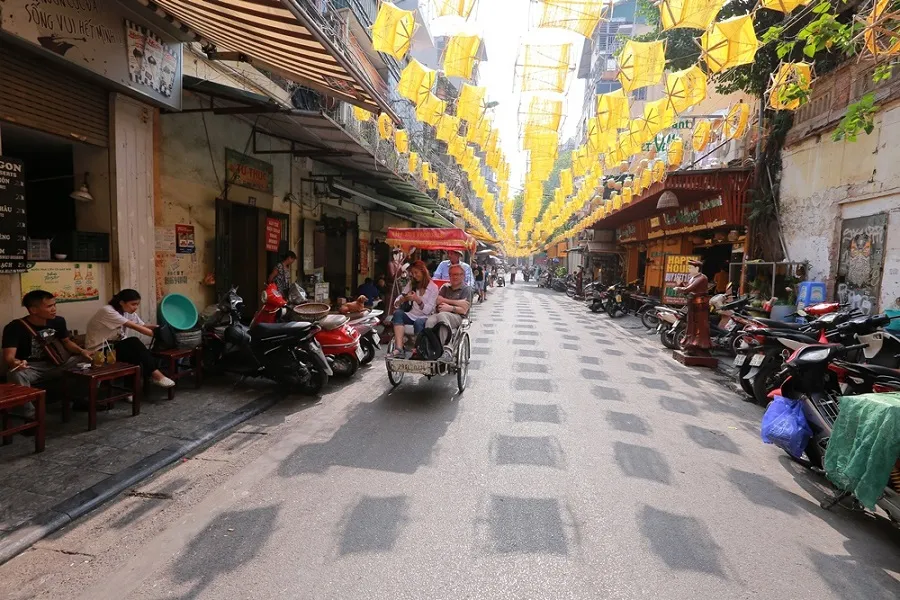
Festival traditions and religious beliefs have been preserved through generations, with festivals such as Lunar New Year, Mid-Autumn Festival, and full moon days featuring distinctive ceremonies, while ancient temples and pagodas like Bach Ma Temple and Cau Dong Pagoda continue to serve as sacred centers, holding a significant place in the community's spiritual life.
Hanoi's street food is an indispensable part of the Old Quarter's cultural identity, with delicious dishes like pho, bun cha, banh mi, and egg coffee not only pleasing the palate but also representing the diversity of culinary arts. Shops, cafes, and layers of merchants from the past to the present have created a diverse cultural space, reflecting a harmonious blend of tradition and modernity.
Performance art is also the essence of the Old Quarter, with traditional shows like cai luong, cheo, and quan ho not only contributing to the artistic atmosphere but also offering both residents and visitors deep dives into Vietnamese cultural life. The Old Quarter, with its alleys, houses, and eateries, is not just a destination but a living museum, where every corner tells a story of Hanoi's culture, history, and soul, an integral part of the capital's cultural exploration journey.

Despite the ups and downs of time, Hanoi 36 streets still retains its charming and unique features. These are the small and beautiful streets, the ancient houses, the colorful shops, the bustling markets, the sacred temples and pagodas, the delicious restaurants, the garden cafes… All create a colorful, diverse and lively picture of Hanoi 36 streets.
Hanoi Old Quarter is the heart of the thousand-year-old capital, located in Hoan Kiem district. To get here, visitors can choose from different modes of transportation, depending on their location and needs:
- If you depart from Noi Bai airport, you can take a taxi, bus, motorbike taxi or Grab. The travel time is about 40 minutes to 1 hour, depending on the traffic situation.
- If you travel from Hanoi station, you can take a bus, motorbike taxi, Grab or walk. The travel time is about 15 minutes to 30 minutes, depending on the traffic situation.
- If you come from other provinces, you can take a coach, limousine, sleeper bus or motorbike. The travel time and cost depend on the distance and type of vehicle you choose.
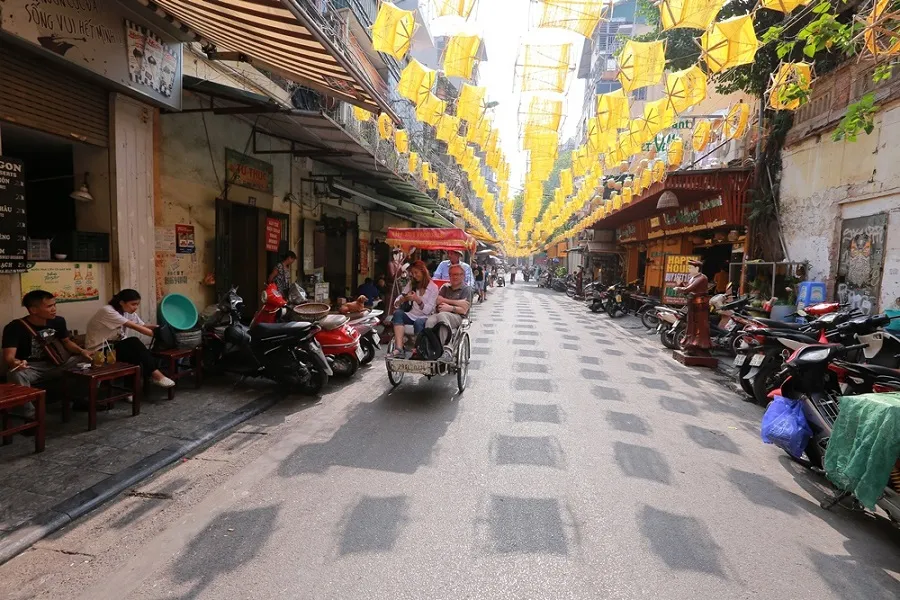
When you arrive at Hanoi Old Quarter, you should walk, cycle or take an electric car to explore the best of the streets and alleys of the old town. You can also rent a bicycle, electric car or cyclo at the nearby parking spots.
Constructed in 1889, the market boasts a unique French architectural style and has witnessed many historical events, serving as a testament to Hanoi's changes over more than a century.
Dong Xuan Market is a hub of commercial and cultural activities. It's not only a shopping center but also a venue for cultural events such as the Tet flower market, food fairs, and traditional festivals. Shoppers inside the market can find a vast array of products ranging from clothing, footwear, and household items to electronics and jewelry, as well as local food and specialties.
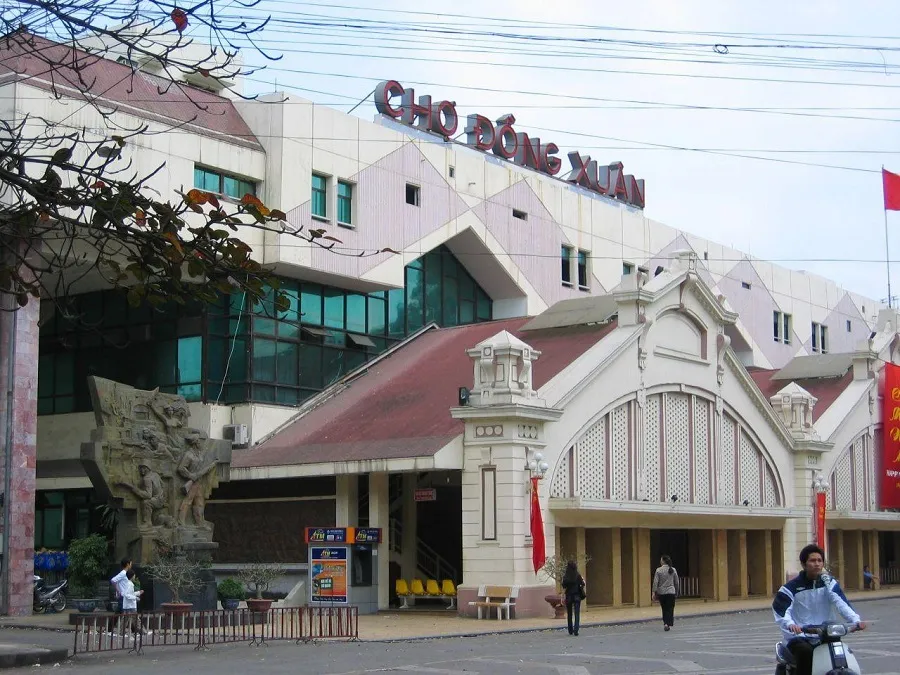
Situated at the heart of the Old Quarter, Dong Xuan Market reflects not only the history and culture but also offers visitors the chance to experience the allure of Hanoi, from its rich traditions to its modern.
O Quan Chuong stands as a symbol of the resilience, fortitude, and heroism of the Hanoians, as well as being one of the remaining ancient gates of Hanoi. Constructed in 1749 with a Chinese architectural style, it features a rectangular design with two stories, four stone columns, a pair of large doors, and two smaller ones, signifying the strength and solemnity of a key defensive point of the city.
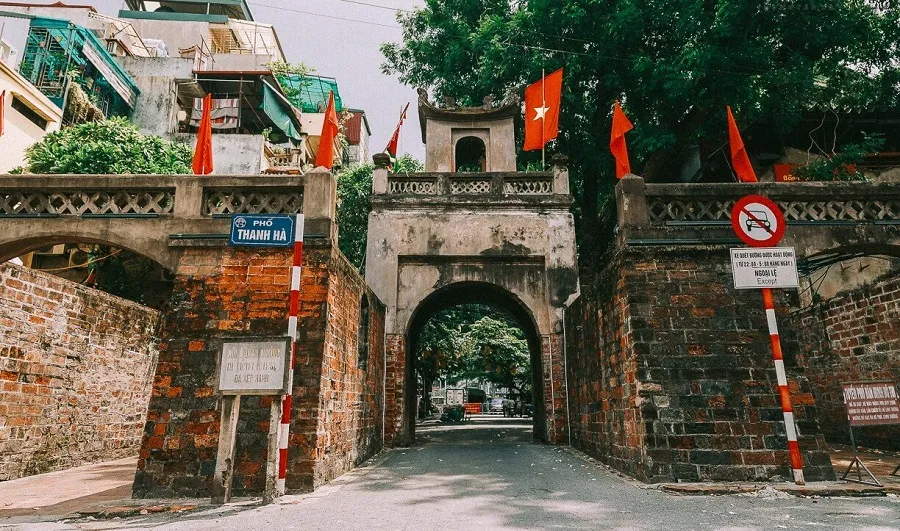
Overlooking the bustling streets of Hanoi, O Quan Chuong has not only been a witness to historical events such as the uprising of Lady Trieu, the resistance against the French, and the August Revolution but also remains an important cultural and historical gathering spot. The gate attracts visitors not only for its historical value but also as an ideal location for photography and regularly hosts cultural and artistic activities like exhibitions, festivals, and community events.
Today, O Quan Chuong serves as a historical relic, an emblem of Hanoi, celebrated for its architectural beauty and cultural significance. For the people of Hanoi, it is more than a piece of history; it is a source of pride, symbolizing the indomitable spirit and heroic character that the city has demonstrated over the centuries.
Bach Ma Temple, nestled in the heart of Hanoi, radiates with traditional beauty and sanctity, making it a must-visit for those who are passionate about exploring the historical and cultural heritage of the capital. Established in the 11th century, it honors the White Horse deity, believed to have assisted King Ly Thai To in selecting the location for his citadel. Bach Ma Temple is constructed in the Vietnamese architectural style, featuring red tiles, wooden columns, a spacious courtyard, and a lotus pond. Visitors come here to seek blessings for luck, wealth, and prosperity and to admire the traditional beauty of Hanoi.
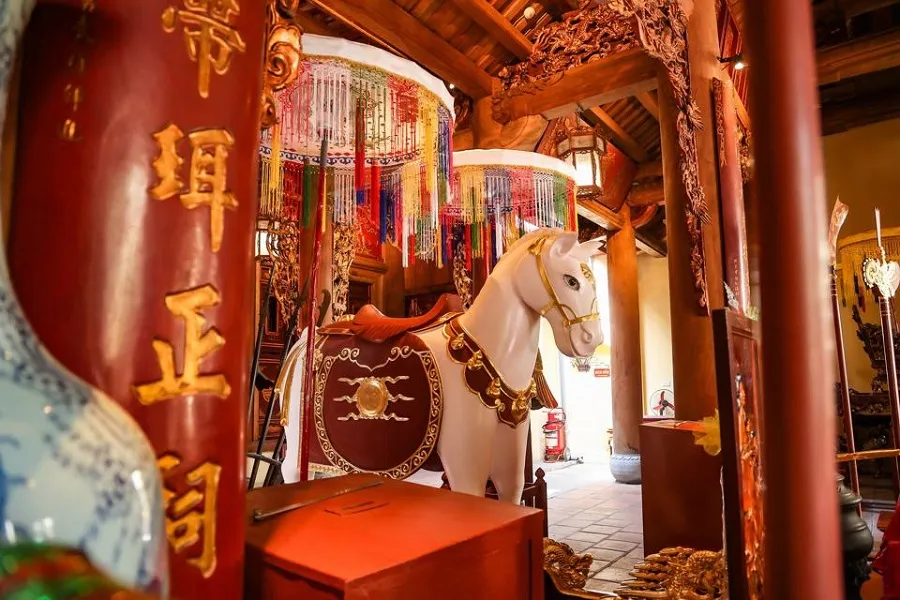
The temple is not only a place of worship but also hosts various cultural events and festivals, drawing large crowds of locals and tourists to pray for good fortune.
During its annual festivals, Bach Ma Temple buzzes with a plethora of traditional activities like lion dancing, processions, and peace-praying rituals. It's also included in cultural tours, where guides elucidate the temple's history and culture, as well as the deities enshrined there.
Beyond its spiritual significance, Bach Ma Temple is a testament to the finesse of Vietnamese architectural and sculptural art. The temple plays a role not just in worship but also in preserving and promoting the unique cultural values of Hanoi and Vietnam.
As one of the most famous and beautiful temples in Hanoi, Ngoc Son Temple is an ideal destination for visitors who love history and culture. Constructed in the 19th century, it is dedicated to Quan The Am (the Goddess of Mercy), Van Xuong (the deity of literature), and notable Vietnamese cultural figures. Ngoc Son Temple is situated on a small island in the middle of Hoan Kiem Lake, connected to the mainland by the red-painted The Huc Bridge. The temple exhibits a blend of Vietnamese and Chinese architectural styles, featuring blue-tiled roofs, wooden columns, a lotus pond, and a bronze bell.
Ngoc Son Temple is not only a place for religious ceremonies and worship but also serves as a venue for a variety of cultural, artistic, and traditional festivals, such as the Lang Temple festival. Additionally, the temple provides visitors with insights into the history of Hoan Kiem Lake, the legend of the Golden Turtle, and the Thuan Thien sword. Ngoc Son Temple stands out not only as a cultural highlight but also as a symbol of tranquility and peace amidst the bustling, modern city of Hanoi.
Hang Ma Street is a unique and characteristic destination in the heart of Hanoi's Old Quarter, with a history intimately connected to traditional crafts and the festival culture of Vietnam. Over the centuries, Hang Ma Street has become the familiar place for those in search of decorative items for significant celebrations like the Lunar New Year, Mid-Autumn Festival, and Christmas. Particularly during the festive periods, the street comes alive as it transforms into a seasonal market filled with a variety of goods from colorful lanterns to vibrant paper animals.
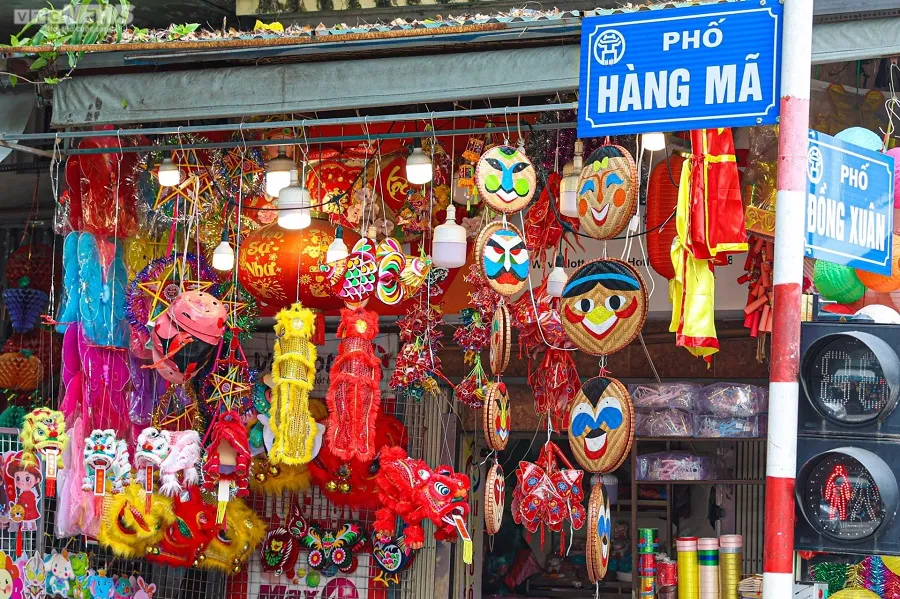
Visitors to Hang Ma Street not only shop but also immerse themselves in a part of Hanoi's diverse and rich culture. It is also the perfect place to capture beautiful photos against the backdrop of vivid colors and to participate in the festive, bustling atmosphere that epitomizes the capital's traditions.
The Ma May ancient house is an architectural relic with a history of over 200 years, one of the few remaining old houses in Hanoi's Old Quarter. This historic house features traditional Vietnamese architecture with tiled roofs, windows, and an inner courtyard. The rooms in Ma May ancient house are divided according to their functions, such as the living room, worship room, and common living area.
Today, the Ma May ancient house is not only a tourist attraction that offers insights into Hanoi's history and culture but also serves as a venue for cultural activities such as exhibitions, introductions to traditional arts, and workshops on crafts. Moreover, the house regularly organizes educational events to preserve and promote Vietnamese cultural values, attracting both local and international visitors.
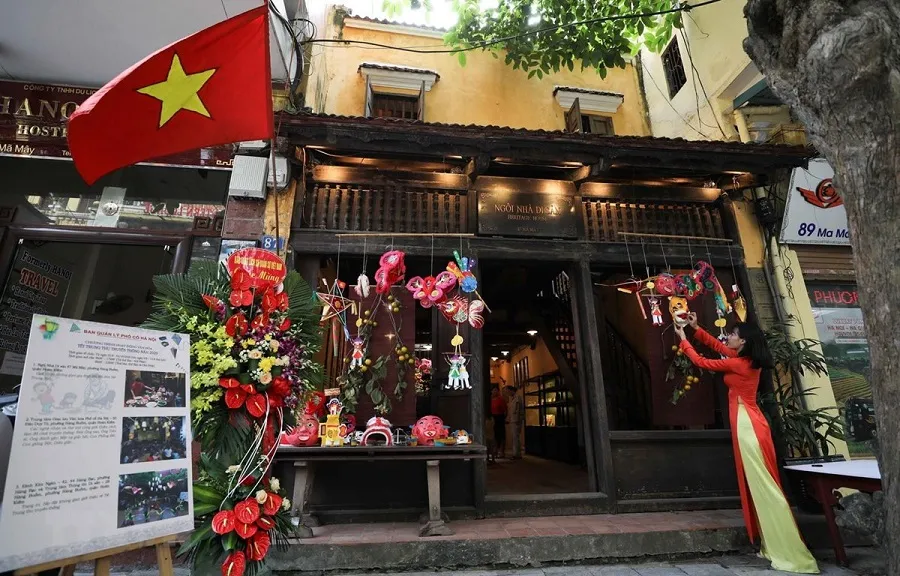
With its historical and unique architectural value, the Ma May ancient house stands as a testament to time and a place for cultural exchange between generations and between locals and international friends.
Ta Hien Street, often dubbed as the "Western Street" within Hanoi's Old Quarter, is renowned for its bustling urban vibe. Although not lengthy, it is a popular gathering spot for both locals and international visitors, especially in the evenings and on weekends.
The history of Ta Hien Street is inseparable from the larger canvas of the Old Quarter, where it has been a busy trading center for centuries. Today, with its array of eateries, taverns, cafes, bars, and karaoke joints, modern Ta Hien Street is a melting pot of rich cultural exchange and reflects a blend of tradition and modernity.
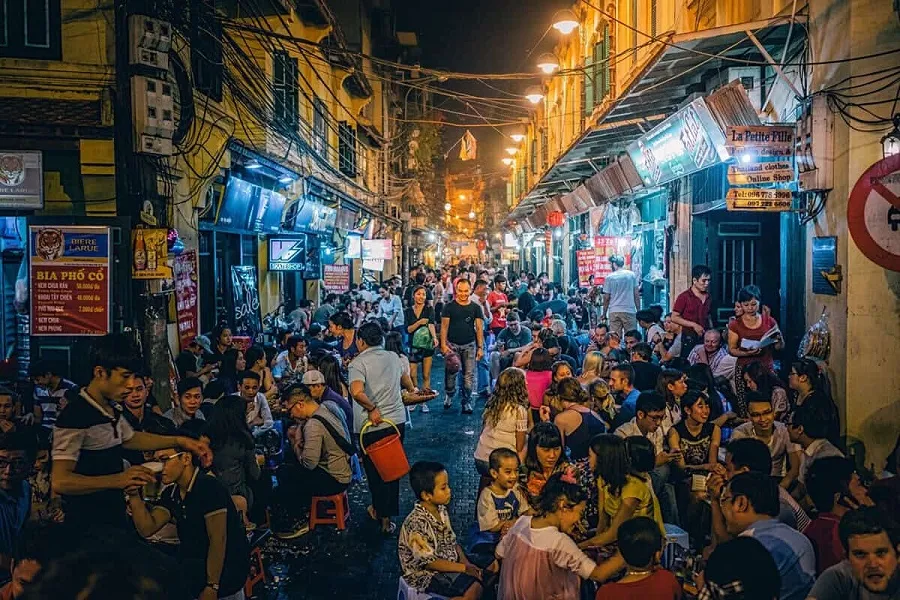
Here, visitors can savor signature Hanoi street foods like pho and bun cha, among a variety of other snacks. The nightlife on Ta Hien Street is particularly vibrant, with live music and DJ performances creating an ongoing festive and liberating atmosphere.
Ta Hien Street also serves as an ideal place for cultural exchange, offering visitors the chance to engage in conversations with Hanoi residents, sharing culture and life experiences. Whether you enjoy the daytime tranquility or the lively night scene, Ta Hien Street always has something new to discover and experience.
Hoan Kiem Lake, also known as Sword Lake, is not just the heart of Hanoi but also a symbol of the city's history and culture. The lake is famous for the legend of King Le Loi, who returned a magical sword to the Golden Turtle God after defeating the Ming army, thus giving the lake its name, which means "Lake of the Returned Sword".
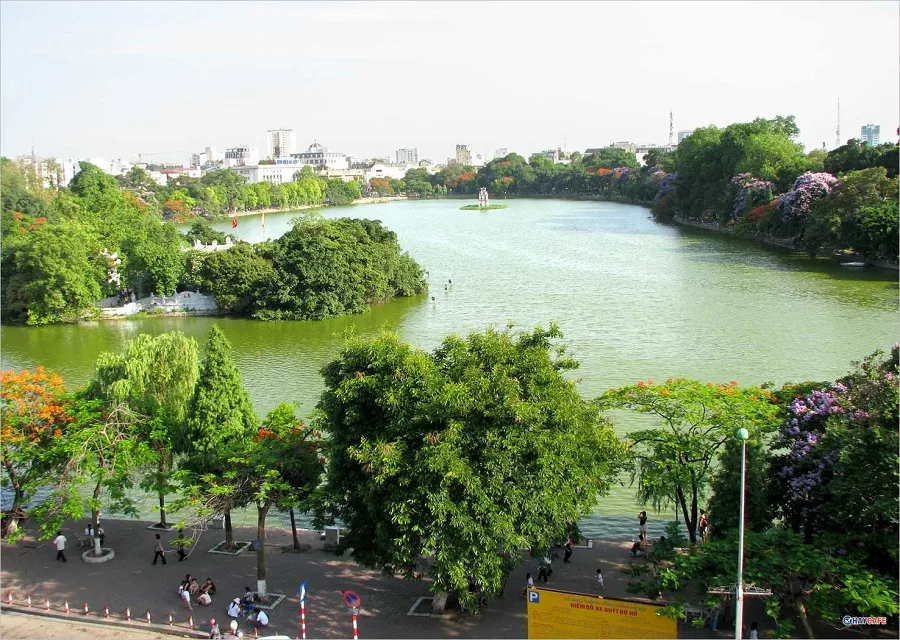
Hoan Kiem Lake is not only a place to enjoy the scenery but also a venue for various cultural and community activities. Every morning, Hanoi residents exercise and practice Tai Chi around the lake, while in the evening, it becomes a popular spot for strolling couples and families. During festivals, Hoan Kiem Lake becomes the focal point for events such as music performances, water puppet shows, and traditional festivals, all integral to the cultural life in Hanoi.
Additionally, several new attractions have emerged, drawing visitors' attention. Noteworthy among them is the Cua Bac Church with its French architecture and modern cultural events; 19/12 Book Street, a haven for book lovers; Hang Ma Gallery, showcasing contemporary art and hosting events; and Wall Street Cafe, a standout street art cafe with a creative design.
Hanoi Old Quarter is not only famous for its culture, history and architecture, but also for its cuisine. There are many delicious, special and cheap dishes for visitors here.

Here are some dishes that you must try when visiting the Old Quarter:
- Bun cha: Bun cha is a typical and famous dish of Hanoi consisting of bun (rice noodles), cha (grilled pork), fish sauce (dipping sauce with sugar, vinegar, garlic, chili, lemon) and vegetables (raw vegetables, water spinach, basil…). The most famous is Bun Cha Huong Lien restaurant on Le Van Huu street, where former US President Barack Obama and famous chef Anthony Bourdain visited.
- Bun oc nguoi: Bun oc nguoi is a dish suitable for hot days, helping to cool down effectively. It consists of bun (rice noodles), oc (snails), vinegar (dipping sauce with vinegar, sugar, garlic, chili, lemon) and vegetables (lettuce, perilla, mint…). Bun oc nguoi has a sour, spicy, sweet and refreshing taste.
- Pho bo: Pho bo is a famous and representative dish of Hanoi cuisine consisting of pho (rice noodles), bo (beef, beef tendon, rare beef, beef flank…), broth (bone broth, onion, ginger, cilantro, cinnamon, star anise…) and vegetables (basil, green onion, bean sprouts, lemon…). Pho bo has a sweet, fragrant, rich and warm taste.
- Nem chua ran: Nem chua is fried until crispy, served with fish sauce (dipping sauce with sugar, vinegar, garlic, chili, lemon) and vegetables (carrot, cucumber, herbs…). Nem has a sour, spicy, sweet, salty, crunchy and greasy taste.
- Bun dau mam tom: is a dish consisting of bun (rice noodles), dau (fried tofu), mam tom (shrimp paste mixed with sugar, vinegar, garlic, chili, lemon) and vegetables (water spinach, coriander, basil…). Bun dau mam tom has a salty, sour, spicy, fragrant and fatty taste. Bun dau mam tom is a delicious, popular and special dish. Visitors can eat bun dau mam tom at many restaurants in Hanoi Old Quarter, but the most famous is Bun Dau Mam Tom Hang Khay restaurant on Hang Khay street.
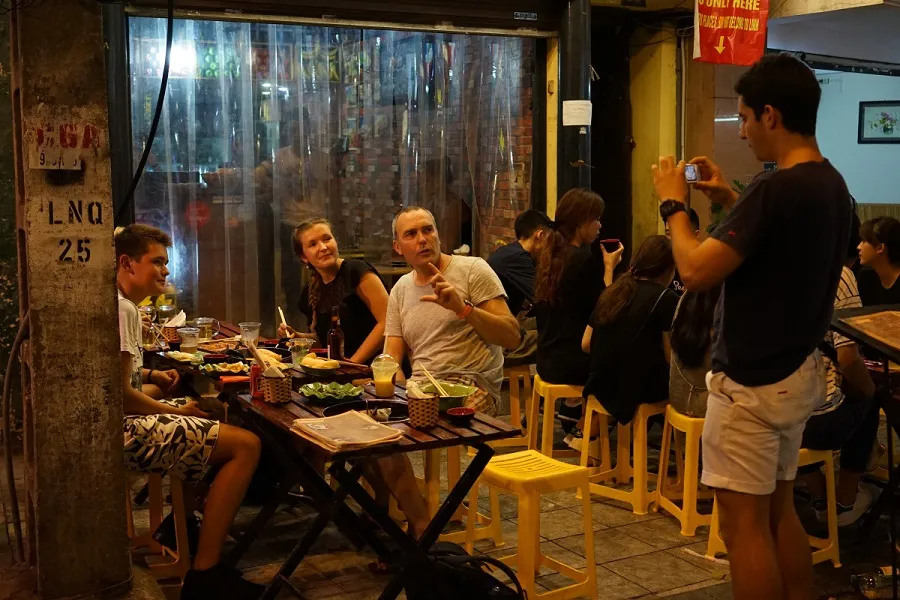
When visiting the Old Quarter in Hanoi, travelers should keep in mind the following tips for the best experience:
- Clothing: Wear comfortable attire appropriate for the weather. Hanoi can get very hot in the summer, so opt for light, breathable clothes. In winter, the temperature can drop significantly, so warm clothing is necessary.
- Footwear: Bring comfortable shoes for walking, as you'll want to explore every nook and cranny of the Old Quarter on foot.
- Weather: Check the weather forecast before you go to prepare accordingly, especially if you're traveling during the rainy season.
- Security: Keep a firm grip on personal belongings and avoid carrying large amounts of cash or valuables while walking through the Old Quarter.
- Cuisine: Try the street food, but be mindful of food hygiene issues.
- Traffic: The Old Quarter of Hanoi is often congested, so choose your visiting times to avoid peak hours.
- Culture and Customs: Respect local traditions and customs, especially when visiting temples, pagodas, and churches.
I hope you will have a fun and meaningful trip to Hanoi Old Quarter with your family and friends.
Copyright © 2022 BDATrip.com | All rights reserved.